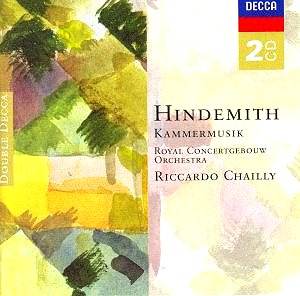Hindemith’s
Kammermusik series is a creature of the 1920s written by one of
the non-conformist young lions of that era. Their locale was Baden-Baden
and Frankfurt. Very much part of the neo-Baroque and Grosz fusion,
the music is freewheeling, swerving, swallow-diving, bouncing
tangentially off circles created by Berg and Weill.
The
organ work (No. 7) is densely overpowering in the first movement,
seemingly suspended wraithlike between worlds in the quiet second
movement and finally full of jerky restlessness. This is music
drained of romance but vigorous and scathing but then nether could
any of these works be accused of being windy or overblown.
Hindemith
finds a certain ruddy-cheeked cheeriness too. The finale of the
viola d’amore work has echoes of the wonderful Schwanendreher
concerto. Kammermusic No. 1 gives the impression of a stripped-down
Petrushka taken hell-for-leather, often sounding like a great
wheezing music box. By contrast the second movement is very tender
and loving. The finale hums with vinegary corrosive action accentuated
by Miny Dekkers’ accordion. If you know the wild xyklophone solo
in first movement of Havergal Brian’s Gothic you will know what
to expect. The deliciously edgy sound of the raucously cheeky
trumpet throughout and the motoric pellmell of it all makes this
set really memorable. Sparks fly everywhere in the brilliant and
hurtling first and last movements of No. 2. Kulka makes quicksilver
capital out of the acridity and vitriol of the Fourth - interesting
to hear him out of his accustomed Szymanowski loop. His pianissimo
sprint in the finale is unremittingly impressive but then Kashkashian
(soon to up-sticks in favour of ECM) makes a similar impression.
These are virtuoso concertos every one.
Slightly
out of the sequence is the Kleine Kammermusik which is
louche and light - rather like Façade. The clarinet
plays the clarinet ragamuffin in Schnelle Viertel. Generally
the woodwind show breathtaking unanimity of attack.
Calum
Macdonald in his fine notes reminds us that the expression ‘Kammermusik’
is best understood by contrast with the grandiloquently specified
orchestras of Mahler and Strauss to which this series was in some
measure a reaction. The Hindemith orchestra here is of modest
scale by comparison. The Chailly-picked members are listed in
the booklet.
Nearly
two hours and twenty minutes of musicmaking and festively brilliant
writing and playing.
Rob
Barnett
